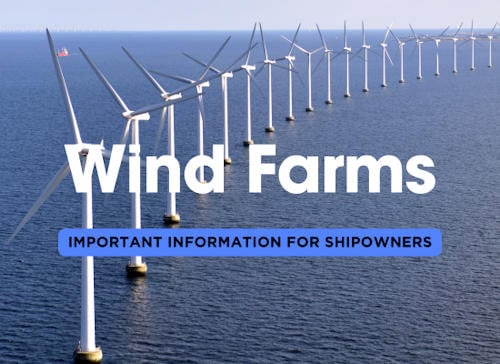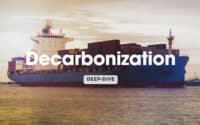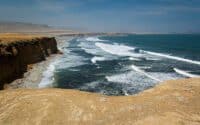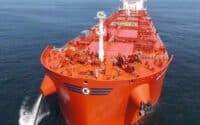The Offshore Wind Boom: What Shipowners Need to Know

Offshore wind farms are not just transforming the energy landscape; they are creating significant opportunities for shipowners. The growth of this sector depends heavily on maritime vessels to support various phases of wind farm projects, from construction to ongoing maintenance. Here’s why this emerging market is important for shipowners:
** The data presented in this article reflects current trends and projections in the offshore wind sector but is subject to change as the industry evolves. We recommend consulting up-to-date sources or industry experts for the most current information.
- Critical Role in Offshore Wind Projects
- Ships and fleets are essential for every phase of offshore wind farm development, including transporting equipment, installing turbines, and maintaining infrastructure.
- Specialized vessels are needed for tasks such as laying subsea cables, transferring crew members, and supporting heavy-lift operations during turbine installation.
- Without maritime support, offshore wind farms cannot be built or maintained efficiently, making shipowners a key part of the supply chain.
- Growing Demand for Specialized Vessels
- As more offshore wind farms are being developed globally, the demand for specialized vessels like jack-up ships, service operation vessels (SOVs), cable-laying vessels, and crew transfer vessels (CTVs) is rapidly increasing.
- Shipowners who invest in or retrofit their vessels for offshore wind can tap into long-term, lucrative contracts for wind farm installation and maintenance projects.
- Governments and energy companies are planning more offshore wind projects, which means sustained demand for fleets capable of supporting these operations over the next several decades.
- New Revenue Opportunities
- Offshore wind farms offer steady work compared to other markets, ensuring consistent utilization of vessels and fewer periods of idle time.
- The renewable energy industry often offers long-term contracts, providing financial stability and predictable revenue streams for shipowners who participate in wind farm support.
- Retrofitting existing vessels or building new ones designed for offshore wind can result in a competitive advantage, allowing shipowners to establish themselves in a rapidly growing market.
| ShipUniverse: Vessel Types and Their Roles in Offshore Wind Farms | |||
|---|---|---|---|
| Vessel Type | Role in Offshore Wind | Key Features | Example Vessels |
| Installation Ships | Used to transport and install large wind turbine components, including towers, blades, and nacelles, onto foundations. | Heavy-lift cranes, dynamic positioning (DP) systems, stability for handling heavy loads in deep water. | Seajacks Scylla, Innovation |
| Cable-Laying Vessels | Specialized in laying subsea power cables that connect wind turbines to the electrical grid onshore. | Precision cable-laying systems, dynamic positioning for accurate cable placement, large cable storage capacity. | Nexans Skagerrak, Aethra |
| Service Operation Vessels (SOVs) | Support the maintenance and operation of offshore wind farms, providing accommodation for crew and technicians. | Dynamic positioning, comfortable living quarters, gangways for safe personnel transfers, long-term deployment capability. | Acta Auriga, Esvagt Froude |
| Jack-Up Vessels | Specialized vessels with legs that can be lowered to the seabed to elevate the vessel, creating a stable platform for turbine installation or maintenance. | Adjustable legs, self-elevating capabilities, heavy-lift cranes, stability in rough sea conditions. | Vole au vent, Brave Tern |
| Crew Transfer Vessels (CTVs) | Designed to transport technicians and equipment to and from offshore wind turbines, ensuring maintenance crews reach turbines safely. | High-speed, stable hull designs, spacious decks for equipment, gangways for safe boarding at wind turbines. | Njord Forseti, Windcat 101 |
| Heavy-Lift Vessels | Used for transporting and installing foundations, substations, and other large components of offshore wind farms. | High-capacity cranes, dynamic positioning, stability for lifting and placing heavy structures. | Thialf, Sleipnir |
Revenue Potential by Vessel Type
As offshore wind farms expand globally, the demand for specialized vessels has created lucrative opportunities for shipowners. Each vessel type plays a vital role in the development and maintenance of wind farms, from installation to ongoing operations. With the right fleet mix, shipowners can secure long-term contracts that ensure stable, high-revenue streams. This table breaks down the average daily charter rates of different vessel types involved in offshore wind projects, alongside real-world examples of contracts and potential annual revenue.
| ShipUniverse: Revenue Potential by Vessel Type | |||
|---|---|---|---|
| Vessel Type | Average Daily Charter Rate | Example Contracts | Potential Revenue per Year |
| Installation Vessel | $150,000 - $250,000 | Wind turbine installation for North Sea wind farms | $54M - $91M (assuming 360 days of operation) |
| Crew Transfer Vessel (CTV) | $5,000 - $12,000 | Maintenance crew transport for offshore wind farms in Europe | $1.8M - $4.3M (assuming 360 days of operation) |
| Cable-Laying Vessel | $50,000 - $130,000 | Subsea power cable installation for U.S. East Coast projects | $18M - $46.8M (assuming 360 days of operation) |
| Service Operation Vessel (SOV) | $30,000 - $60,000 | Wind turbine maintenance support in the Baltic Sea | $10.8M - $21.6M (assuming 360 days of operation) |
| Heavy-Lift Vessel | $200,000 - $400,000 | Foundation and substation installation in North Sea projects | $72M - $144M (assuming 360 days of operation) |
| ShipUniverse: Revenue Potential by Vessel Type | |||
|---|---|---|---|
| Vessel Type | Average Daily Charter Rate | Example Contracts | Typical Project Duration |
| Installation Vessel | $150,000 - $250,000 | Wind turbine installation for North Sea wind farms | 6-12 months for full turbine installation |
| Crew Transfer Vessel (CTV) | $5,000 - $12,000 | Maintenance crew transport for offshore wind farms in Europe | Year-round for regular maintenance |
| Cable-Laying Vessel | $50,000 - $130,000 | Subsea power cable installation for U.S. East Coast projects | 3-6 months for cable laying and connection |
| Service Operation Vessel (SOV) | $30,000 - $60,000 | Wind turbine maintenance support in the Baltic Sea | Ongoing, long-term contracts (often several years) |
| Heavy-Lift Vessel | $200,000 - $400,000 | Foundation and substation installation in North Sea projects | 6-12 months for large-scale installations |
Economic Benefits of Offshore Wind for Shipowners
The growth of offshore wind farms offers significant economic opportunities for shipowners, providing long-term revenue streams, increased fleet utilization, and a steady demand for specialized vessels. By aligning with the offshore wind sector, shipowners can tap into this booming industry while contributing to a sustainable future. Here are the key economic benefits for shipowners:
- Steady, Long-Term Contracts
- Offshore wind projects often require long-term contracts (6-12 months or more) for vessels during the installation, maintenance, and operation phases.
- Shipowners can secure multi-year service agreements for vessels like Service Operation Vessels (SOVs) and Crew Transfer Vessels (CTVs), providing predictable income streams and reducing fleet downtime.
- Increased Vessel Utilization
- Offshore wind farms require continuous support for operations and maintenance, ensuring high utilization rates for vessels, unlike cyclical sectors like oil and gas.
- Shipowners can benefit from consistent work with fewer idle periods, maximizing the return on investment (ROI) for their vessels.
- Lucrative Charter Rates
- Specialized vessels such as installation ships, cable-laying vessels, and heavy-lift vessels command premium charter rates due to the complexity and scale of offshore wind projects.
- Installation vessels can earn $150,000 to $250,000 per day, while heavy-lift vessels can charge up to $400,000 daily for large-scale projects.
- Diverse Revenue Streams
- Offshore wind projects generate revenue across multiple phases, from seabed surveying to turbine installation, ongoing maintenance, and cable laying.
- This diversification helps shipowners spread financial risk and capture revenue from various parts of the project lifecycle.
- Government Support and Subsidies
- Many governments offer financial incentives, tax breaks, and subsidies to accelerate the development of offshore wind energy.
- Shipowners that align their fleets with offshore wind activities may benefit from regulatory and financial support, making it easier to finance vessel upgrades or new builds.
- First-Mover Advantage
- As the offshore wind industry grows, early adopters who invest in or retrofit vessels for wind farm operations can establish themselves as key players, gaining a competitive edge in securing contracts.
- Shipowners that enter the market early can build long-term relationships with energy companies, ensuring future growth as the industry expands globally.
- Contribution to Decarbonization Goals
- With increasing pressure on the maritime sector to reduce emissions, shipowners can position their fleets as essential contributors to clean energy infrastructure.
- Vessels servicing offshore wind farms play a role in the green energy transition, potentially attracting partnerships and financial incentives aimed at sustainability.
Offshore Wind Farm Projects by Region
The offshore wind energy sector is expanding rapidly across multiple regions, with significant projects underway in Europe, North America, and Asia. Each region presents unique challenges and opportunities for shipowners, including different vessel demands and timelines for completion. As governments push for renewable energy targets, the number of offshore wind farms is expected to increase, creating long-term opportunities for maritime support services.
| ShipUniverse: Offshore Wind Farm Projects by Region | |||
|---|---|---|---|
| Region | Number of Projects | Vessel Demand | Expected Completion Date |
| North Sea | 60+ major projects |
- High demand for installation vessels, heavy-lift vessels, and cable-laying ships. - Growing need for SOVs and CTVs for long-term maintenance and operations. - Jack-up vessels required for foundation installation in deep waters. |
2030 for many large-scale projects (Dogger Bank, Hornsea, etc.) |
| U.S. East Coast | 15+ projects (including Vineyard Wind, Empire Wind) |
- High demand for cable-laying vessels and heavy-lift vessels. - Moderate demand for SOVs and installation ships as projects ramp up. - CTV demand expected to increase for crew transfer and maintenance support. |
2025-2030 for most large-scale developments |
| Baltic Sea | 20+ projects (including Kriegers Flak, Baltic Eagle) |
- High demand for jack-up vessels and installation ships due to challenging seabed conditions. - SOV and CTV demand remains steady for maintenance and operations. - Cable-laying vessels needed for connecting offshore grids. |
2026-2032 for various large-scale installations |
| Asia-Pacific (Taiwan, South Korea, Japan) | 25+ projects (including Formosa 1, Yunlin) |
- Increasing demand for jack-up vessels and heavy-lift ships for turbine installation. - Cable-laying vessels in demand for long-distance power grid connections. - CTV and SOV demand rising as operations begin for early projects. |
2025-2035 depending on project size and region |
| United Kingdom (Scottish Waters) | 10+ projects (including Seagreen, Neart na Gaoithe) |
- Heavy demand for installation vessels and jack-up ships due to deeper waters and challenging conditions. - High demand for SOVs and CTVs for maintenance of operational wind farms. - Cable-laying vessels needed for connecting offshore farms to mainland grids. |
2026-2030 for many upcoming projects |
| North America (Canada, Gulf of Mexico) | 5+ early-stage projects |
- Low demand for now, but expected to increase as offshore wind expands in North America. - Anticipated demand for installation vessels, jack-up ships, and SOVs for future projects. |
2030+ for early-stage developments |
Retrofitting Possibilities
With the rapid growth of offshore wind farms globally, shipowners face the decision of either building new specialized vessels or retrofitting existing ones to meet the demands of this expanding sector. Retrofitting existing vessels is a cost-effective alternative that allows shipowners to capitalize on the offshore wind market without the high upfront costs of new builds. However, not all vessels are equally suited for retrofitting, and the scope of modifications required varies based on vessel type and project needs. This table outlines key retrofitting possibilities for common vessel types, highlighting the modifications needed and their potential roles in offshore wind operations.
| ShipUniverse: Retrofitting Possibilities for Offshore Wind Support Vessels | |||
|---|---|---|---|
| Vessel Type | Potential Retrofitting Modifications | New Role in Offshore Wind | Retrofit Timeframe |
| Platform Supply Vessel (PSV) |
- Install dynamic positioning (DP2 or DP3) for precision station-keeping. - Add gangways for safe crew transfer. - Retrofit with hybrid propulsion systems to reduce emissions. |
Service Operation Vessel (SOV) for maintenance and crew accommodation at offshore wind farms. | 6-9 months |
| Anchor Handling Tug Supply (AHTS) |
- Reinforce deck for heavy-lift capabilities. - Install DP systems for precise positioning during anchor/mooring deployment. - Add specialized cranes for installation and support tasks. |
Heavy-lift vessel or mooring support for floating offshore wind farms. | 6-12 months |
| Construction Vessel |
- Upgrade lifting capacity with stronger cranes. - Add advanced positioning and navigation systems. - Retrofit to handle larger components like wind turbine towers and blades. |
Installation vessel for offshore wind turbine construction. | 9-15 months |
| Older Crew Transfer Vessel (CTV) |
- Refurbish interiors and upgrade safety features. - Add hybrid or fully electric propulsion systems to reduce carbon footprint. - Retrofit hull for improved stability in rough seas. |
Renewed CTV for ongoing crew transfers to offshore wind turbines. | 3-6 months |
| Survey Vessel |
- Upgrade sonar and seabed mapping equipment. - Install dynamic positioning for precise surveying operations. - Retrofit for better endurance and crew capacity. |
Seabed survey vessel for pre-installation assessments. | 6-9 months |
The rise of offshore wind farms marks a pivotal moment for the maritime industry, creating unique and exciting opportunities for shipowners willing to adapt and innovate. Retrofitting vessels to meet the specific demands of this growing sector not only offers a lucrative entry point into the renewable energy market but also positions shipowners at the forefront of a global push toward sustainability. With long-term contracts, steady vessel utilization, and advancements in green technology, the offshore wind sector is reshaping the future of maritime shipping.
As governments and organizations worldwide ramp up their efforts to build a cleaner, greener energy infrastructure, the maritime industry’s role has never been more important. For shipowners, this is a chance to capitalize on a dynamic and fast-evolving market, contributing to a sustainable future while securing a profitable and stable path forward. The possibilities are vast, and the time to embrace the future of offshore wind is now.
Additional References
International Energy Agency (IEA) – Offshore Wind Outlook
- URL: https://www.iea.org/reports/offshore-wind-outlook-2019
- Description: The IEA provides an in-depth analysis of the global offshore wind market, trends in development, and projections for future growth. It covers regional developments, policies, and the role of offshore wind in energy transitions.
Global Wind Energy Council (GWEC) – Offshore Wind Report
- URL: https://gwec.net/publications/offshore-wind/
- Description: GWEC is an international organization that tracks offshore wind projects and market trends globally. Their reports provide updates on installed capacity, upcoming projects, and key regions leading in offshore wind development.
WindEurope – Offshore Wind Statistics and Reports
- URL: https://windeurope.org/about-wind/statistics/offshore/
- Description: WindEurope is the leading European wind energy association, providing statistics and reports on offshore wind development across Europe, including the North Sea, Baltic Sea, and UK waters.
International Renewable Energy Agency (IRENA) – Offshore Wind Energy
- URL: https://www.irena.org/renewables/Offshore-Wind
- Description: IRENA’s offshore wind section offers insights into global offshore wind capacity, regional trends, and technologies, as well as policy frameworks supporting the growth of offshore wind energy.
Offshore Renewable Energy (ORE) Catapult
- URL: https://ore.catapult.org.uk/
- Description: ORE Catapult is the UK’s leading technology innovation and research center for offshore renewable energy. It provides resources, research, and insights into offshore wind technology, market potential, and vessel requirements.
European Wind Energy Association (EWEA) – Offshore Wind
- URL: https://windeurope.org/
- Description: EWEA focuses on the development of wind energy in Europe and tracks offshore wind capacity, regional initiatives, and vessel demand for offshore projects, especially in the North and Baltic Seas.
The Crown Estate – Offshore Wind Projects in UK Waters
- URL: https://www.thecrownestate.co.uk/en-gb/what-we-do/on-the-seabed/offshore-wind/
- Description: The Crown Estate manages the seabed around the UK and oversees leasing for offshore wind farms. This site offers insights into ongoing projects, vessel requirements, and opportunities in UK waters.
European Commission – Offshore Renewable Energy Strategy
Description: The European Commission provides details on the EU’s strategy for offshore renewable energy, including offshore wind, focusing on projects, funding opportunities, and the expected vessel demand for European offshore wind farms.
URL: https://ec.europa.eu/energy/topics/renewable-energy/offshore-renewable-energy_en

Do you have a Maritime Product or Service that may be of interest to Shipowners? Tell us about it here!
Do you have feedback or insights? Please reach out to editor @ shipuniverse.com



